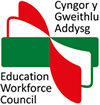It’s been a while since youth work was formally inspected. Work to develop a standalone form of youth work inspection by Estyn is underway and youth work inspection will be reintroduced from late 2024. The reintroduction of inspection follows the introduction of the Youth Work Quality Mark for Wales. In this blog, we will explain what inspection is and how the Youth Work Quality Mark complements it.
Youth work has been considered as part of local authority inspections, but introducing a stand-alone inspection for the whole of youth work will help to highlight the important contribution this education field is making to the lives of young people in Wales. It will also help to underline the legislative basis for youth work, including its statutory basis, and the importance of maintaining a vibrant voluntary youth work sector.
Estyn colleagues, along with representatives from across the youth work field, are in the process of refining the detail of what inspection will actually look like, a process which will continue until the pilot inspections are completed in early 2024. This collegiate approach will ensure that the inspection process is supportive and meaningful, as well as being a key driver for service improvement.
When we work with young people, the quality of our interventions are often hard to define. That moment of engagement, when a young person has turned an emotional corner, grasped an opportunity, or worked out a solution to a problem are the highs in many youth workers’ careers.
These moments are often the result of many hours of planning, reflection, development, or change. Listening and responding to young people is critical. These breakthroughs are examples of the principles and values of youth work making a real difference to a young person. Sometimes, the youth work sector itself generalises this by justifying it as ‘just part of the job’. We must not lose sight of the fact that youth workers often go that extra mile to help and support young people. These moments, and the preparation for them, should be celebrated. Understanding and evaluating the impact of the work we do is a crucial part of self-evaluation and supports organisations to further improve their youth work.
High-quality youth work has a crucial role to play in supporting many young people to achieve their full potential and successfully negotiate key transitions between the ages of 11-25. Through informal and non-formal educational approaches, effective youth work practice builds the capacity and resilience of young people, and can change their lives for the better. Through participation in youth work, young people gain confidence and competence, develop self-assurance, and have the opportunity to establish high expectations and aspirations for themselves.
The Quality Mark for Youth Work in Wales enables organisations to celebrate these moments, and the hard work and endeavour it takes to achieve them. It aids service improvement through reflection and review. The voluntary nature of this process demonstrates a commitment to excellence via a route of self-assessment and peer assessment. Achieving the Quality Mark brings many benefits to organisations. Most notably, having a badge of excellence which shows they are truly delivering a service to young people which you, your peers, and Wales can be proud of.
Youth work inspection will enhance the recognition of youth work in the eyes of those with significant influence, such as the Welsh Government, senior management of organisations, external funding bodies, and others. Inspection in particular aims to have this kind of influence on the education field, inside local authorities, schools, the FE sector, other employers, government, unions and funders. This is achieved by promoting the status of youth work alongside other education professions.
The intention is that the reintroduction of inspection provides public scrutiny and recognition. In turn, it is hoped that this will raise the profile of youth work, providing the whole field with a platform for improvement and opportunity. All statutory education services, and their governance bodies, are required to be publicly accountable via the inspection process, including local authority youth services. Voluntary sector youth work groups will also be included.
Inspection also provides public feedback on youth work for young people and the wider community about the youth work happening in their area. The Quality Mark assessment does not result in a published report, but inspection will. However, both will be focused on highlighting innovation and good practice. Any concerns arising are highlighted in a supportive and empowering way to help organisations provide the best possible services for young people.
The Quality Mark has a self-assessment element which is available for all youth work organisations in Wales to use regardless of their size, where they receive their funding, or whether they then take the step to being externally verified. Estyn will use the self-assessment and improvement planning processes that organisations already have in place as the starting point for inspection and providers won’t be expected to produce any additional documentation before an inspection.
Because of the legislative requirement to inspect youth work, the main key difference between Quality Mark and inspection is that the Quality Mark is voluntarily applied for, whilst inspection is mandatory.
Like the Quality Mark, the inspection process will involve uploading evidence to a virtual area. Estyn will also provide a number of guidance documents with the provider in the same way. There is no expectation that providers prepare documentation specifically for inspection, only to share their internal reporting and quality assurance reports. The process for assessing the Quality Mark and the inspection process helps to focus on the importance of effective self-evaluation. Inspection can be seen as a way of validating the types of service improvement that were prompted and encouraged by Quality Mark assessment. During an inspection, inspectors primary evidence base comes though meetings with young people, youth workers, and other key partners, and observing first hand youth work happening.

